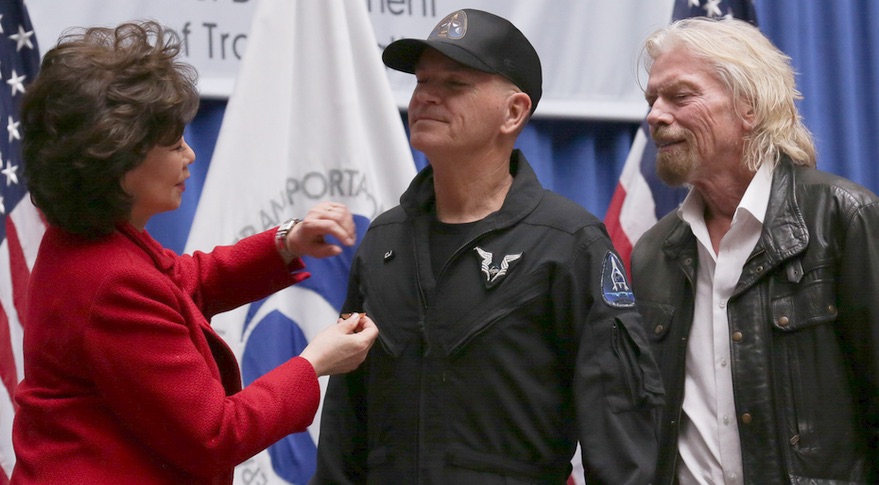
WASHINGTON — The two pilots who flew SpaceShipTwo to the edge of space in December received commercial astronaut wings last week, joining an elite group that won’t necessarily become much larger even with the anticipated growth of commercial spaceflight.
In a Feb. 7 ceremony at the headquarters of the Department of Transportation here, Secretary of Transportation Elaine Chao formally awarded commercial astronaut wings to Mark “Forger” Stucky and Frederick “CJ” Sturckow, the Virgin Galactic plots who flew the SpaceShipTwo suborbital spaceplane to an altitude of nearly 83 kilometers Dec. 13.
“Receiving commercial astronaut wings is an honor for me as it is acknowledgment of a personal achievement,” Stuck said in a company statement, thanking the employees of Virgin Galactic and its subsidiary The Spaceship Company, as well as Scaled Composites, which designed the vehicle. “And these wings are really dedicated to them.”
The Federal Aviation Administration, like the U.S. Air Force and NASA, awards astronaut wings to astronauts who fly above an altitude of 50 miles, or approximately 80 kilometers. This is below the 100-kilometer altitude of the Karman Line, which is commonly used as a standard, although not official, boundary of space. The Fédération Aéronautique Internationale (FAI), the world air sports federation that maintains records for both aviation and spaceflight, said in November that it planned to reconsider the altitude of the Karman Line, suggesting it might be moved down to 80 kilometers.
Stucky and Sturckow are only the third and four individuals to receive FAA astronaut wings. The agency announced plans to award wings in 2004 as Scaled Composites was testing its SpaceShipOne vehicle. Mike Melvill received the first wings in June 2004 after the first flight of SpaceShipOne beyond 80 kilometers, while Brian Binnie received wings for that vehicle’s final powered flight in October 2004.
In remarks at the event, Chao hailed the flight that earned Stucky and Sturckow their wings as part of a “rocket renaissance” in commercial spaceflight. “Today we award the first of what I hope will be many more commercial astronaut wings,” she said.
However, there may only be a handful of such wings awarded in the near future. The FAA plans to give wings only to those who fly as crewmembers on FAA-licensed launches that go above 50 miles. Crewmembers have to meet specific requirements laid out in federal regulations, including holding an FAA second-class airman medical certificate and meeting specific training requirements in order to safely operate the vehicle. Spaceflight participants, those who fly on the vehicle but have no role operating the vehicle, will not be eligible for wings.
Those requirements will strictly limit the number of additional commercial astronaut wings awarded in the near future. Several other Virgin Galactic pilots, including chief pilot Dave Mackay, are expected to fly SpaceShipTwo in upcoming test flights and later commercial service, and thus will be eligible for wings.
The situation is different for Blue Origin, the other company actively developing a crewed suborbital vehicle. Its New Shepard vehicle is remotely piloted, and has yet to carry people on its 10 test flights to date. The company plans to start flying people on New Shepard later this year, initially with company employees as the flight test program continues. It’s not clear of these people will be eligible for FAA astronaut wings, though, since they will not be piloting the vehicle.
Boeing and SpaceX are developing crewed orbital vehicles, CST-100 Starliner and Crew Dragon, for NASA’s commercial crew program. However, initial flights of the vehicle will carry astronauts for NASA and other government agencies, even though operational missions will be licensed by the FAA.
If the astronauts on commercial crew missions are deemed eligible for FAA astronaut wings, in addition to NASA astronaut wings, they will not be the first to receive both sets of wings. Sturckow is a former NASA astronaut who flew on four shuttle missions prior to joining Virgin Galactic.
Related
ncG1vNJzZmiroJawprrEsKpnm5%2BifLe10aCgp2WXlrmir9OimmaomaG8tb%2BMo6aipl2Wu26x15yjrquZq7Jur8uumWavmam1brLAmmSaq6SnvK%2Bt1K1ksKGenMBw